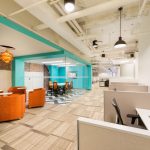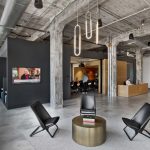Creating a collaborative work environment is vital in today’s fast-paced business world. When employees collaborate effectively, they can generate fresh ideas, increase productivity, and foster a sense of teamwork. One key way to promote collaboration is through office design.
The physical layout and design of an office can have a significant impact on how employees interact with each other and work together. Here are some tips on creating a collaborative work environment through office design:
1. Open floor plan: An open floor plan encourages communication and collaboration among employees. It creates a sense of openness and transparency that can foster a more collaborative work environment. By removing barriers such as walls and cubicles, employees are more likely to interact with each other and share ideas.
2. Communal spaces: Designing communal spaces such as break rooms, meeting rooms, and collaboration areas can encourage employees to come together and work as a team. These spaces should be comfortable, inviting, and equipped with the necessary technology to facilitate collaboration.
3. Flexible workspaces: Providing employees with flexible workspaces can enhance collaboration by allowing them to choose where and how they work. This could include hot-desking arrangements, standing desks, or co-working spaces that can accommodate different work styles and preferences.
4. Technology integration: Incorporating technology into the office design can facilitate collaboration by making it easier for employees to communicate and share information. This could include video conferencing capabilities, screen-sharing technology, and collaboration tools such as Slack or Microsoft Teams.
5. Natural light and greenery: Natural light and greenery have been shown to have a positive impact on employees’ well-being and productivity. By incorporating these elements into the office design, employees are more likely to feel inspired and motivated to collaborate with their colleagues.
6. Personalization: Allowing employees to personalize their workspaces can create a sense of ownership and belonging, which can in turn foster collaboration. Encouraging employees to decorate their desks or work areas in a way that reflects their personalities can help create a more collaborative and inclusive work environment.
In conclusion, creating a collaborative work environment through office design is essential for fostering teamwork, creativity, and productivity. By implementing these tips and incorporating elements that promote collaboration, businesses can create a workspace that inspires employees to work together towards common goals. Ultimately, a collaborative work environment leads to a more engaged and motivated workforce, which can drive success for the organization as a whole.
 darbylanefurniture.com Interior design ideas with the latest interior inspiration
darbylanefurniture.com Interior design ideas with the latest interior inspiration



















